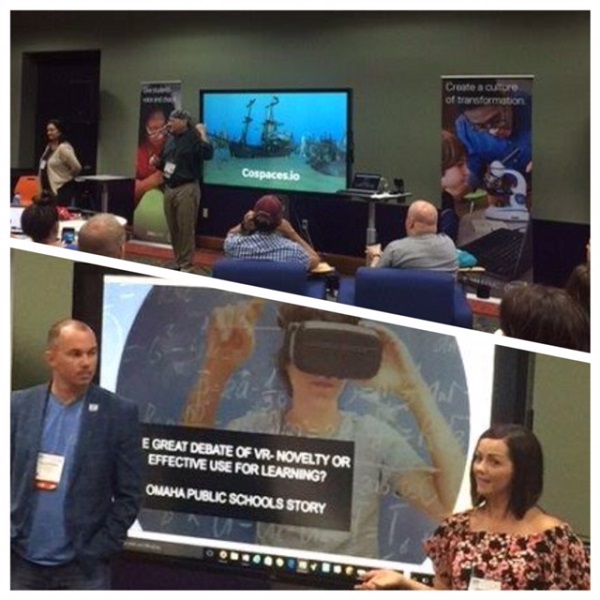The virtual reality meme at the ISTE 2017 conference this year reached a high mark, both in the quantity and quality of educational sessions offered. (The ISTE 2017 educational technology conference held in late June, with over 15,000 educators in attendance, is considered the largest ed-tech conference in the U.S. Every state and more than 72 countries were represented at this year’s ed-tech extravaganza.) In this piece, I will highlight the VR trends and observations from ISTE education sessions that speak to the educational market:
 For the first time, a ginormous banner welcomed VR at ISTE
For the first time, a ginormous banner welcomed VR at ISTE
Observable Trends
VR outshines AR. Although both VR and AR technologies were well represented at ISTE 2017 in educator, student, and university presentations, VR clearly outpaced AR by at least a 3:1 advantage. For now.
VR as grassroots. The conference sessions were replete with ordinary teachers showcasing what they were doing with virtual reality in real classrooms. On the other hand, everyone wants a piece of the action. Companies like Dell were offering breakout conference sessions on the theme of virtual reality, featuring novice school-based presenters, aiming to get their hands in the mix of this seemingly irresistible force. “Me, too!” is the cry. I was not impressed.
 Above, a sampling of the many teacher presenters featuring VR at ISTE. Below, two of the teacher-conducted presentations hosted by Dell.
Above, a sampling of the many teacher presenters featuring VR at ISTE. Below, two of the teacher-conducted presentations hosted by Dell.

Access is enough. Unfortunately, just having VR is enough of a reward for most educators. Most presentations involved very basic uses of virtual reality, e.g., field trips. On average there is not always a lot of thought about how it is being used. But there are exceptions, which will be described in the next section below.
Google pervades. Google has emerged, simultaneously, as both lowest common denominator and dominator; the big kahuna and the ‘grass’ in grassroots. Free stuff, in this case, with VR, carries the day in education, don’t you think?
Disintermediation. Education in the U.S. is an endeavor that gravitates toward disintermediation at every level, whenever possible. Close the classroom door, and teachers can do whatever they want. That explains why many schools and classrooms are making VR happen on their own, not waiting in line for approval, authorization, or formalization by Google or anyone. No, they are jumping right in. Get out of their way. If they want VR, they will get it. Impatient teachers are setting up their own carts, viewers, and curriculum. Interestingly, many experienced educators and administrators are surprised by the rapid pace of this innovation’s infusion. These leaders are finding the need to play catch up.
Content creation thrives. Based on the direction evidenced in a growing number of conference sessions, VR as a passive viewing experience will slowly be outpaced by the desire to have students themselves create the virtual reality environment, whenever possible. It’s an expected development.
Putting AR and VR in the hands of children, as makers.
Pleasant Surprises
The ISTE 2017 conference markedly underscored the apparent tug of war under way between the expected and prosaic uses of VR versus more astute and visionary applications. Some noteworthy presentations involved:
Going global. Organizations like Digital Promise Global and Global Nomad had a solid presence at ISTE, with Nomad featuring their work in empathy and tolerance, while Digital Promise pushed their 360 Filmmakers Challenge student competition.
Aiming at academic achievement. Three poster sessions focused on employing VR interventions to improve student achievement. These presentations sought to influence passersby with actual evidence of the effectiveness of VR visualization in instruction. Two sessions by Cindy Shyu and Y. Chou (Tamkang University, Taiwan) showed the benefits of VR in Physics instruction, while Brian Seymour of the Pickering School District (OH) demonstrated improved writing skills, which became far “more vivid and detailed”, after student use of virtual reality.
3D Network panel. The ISTE 3D Network PLN offered its annual panel presentation featuring the work of Payod Panda, Michael Fricano, Jr., Joy Schwartz, and Len Scrogan. Panda expanded his effort to showcase his Panoform student-created VR (see past Display Daily article, VR for the Crayon Crowd); Fricano, Jr. outlined some mature uses of virtual reality in his high school, focusing on content creation; Joy Schwartz impressed the audience with her 3D printing classroom projects; and Len Scrogan explained how and why students will sometimes get sick when viewing virtual reality in the classroom.
3D Network panel and their facilitator.
Payod Panda in action at the ISTE Playgrounds
Speaking out in VR. One innovative refrain emerging at the ISTE conference involved the creative adaptation of virtual reality to modern language instruction. The notion in all cases was to place students in contextual settings to allow the desired language to flow more naturally than is accommodated through skilled drilling and repetition in the classroom. Presentations included simulations of travel to Barcelona; Moroccan students learning English in simulated trips to Las Vegas; and students in Hawaii mastering Chinese with the help of student-created virtual reality.
–Len Scrogan

